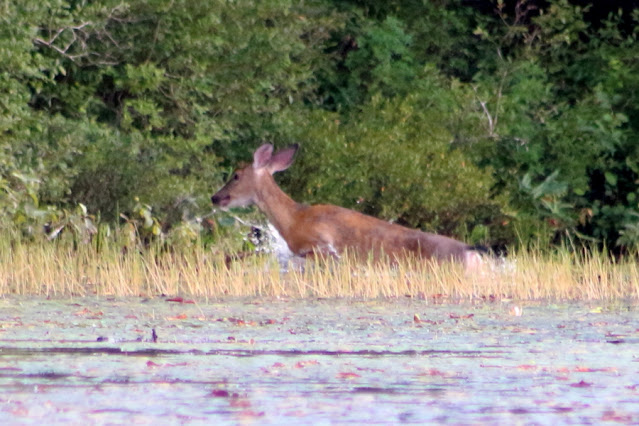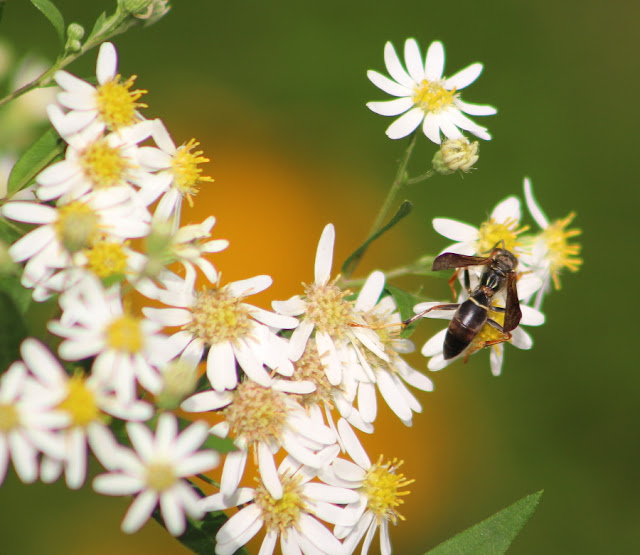Our compost pile has been disturbed regularly the past couple of weeks even though we don't put anything other than plant-based material in it. I think the attraction is the Moulton Farm corn cobs that have been a constant staple in the pile since mid-summer. So I set up the trail camera to see who's been visiting. In the first night I caught three different guests.
 |
| A raccoon on a midnight raid to the compost pile. |
The guilty party as far as pulling the pile apart to get what's buried deep inside is, as I suspected, a raccoon. The camera recorded it climbing over and around the pile to locate the best pickings, and digging in to haul them out. The raccoon seemed to skedaddle out of there right before a larger 'coon arrived, though this one didn't seem to find anything of interest in the pile and quickly went on its way. There were other visitors as well. After the raccoons, a skunk stopped by, but it didn't find anything of interest either. It was raining at the time of the skunk's visit so the picture is poor. Finally, a coyote arrived, sniffed around to check out all the prior visitors, then went on its way, but only after adding its own scent to the pile. You can watch the nighttime action here:
Other animals are busy around the lake as well. The beavers are back out every night, building scent mounds to mark their territory, collecting food for the winter, and securing building materials to reinforce their lodges for the coming cold.
This beaver lodge appears to have grown higher by another two feet this year.
I've seen an abundance of pickerel frogs this summer, hopping all around the yard.
Either the rain has helped them multiply, or the heron and snakes aren't doing their job to thin the population.
On a recent walk on Meredith Neck a good friend steered us towards an interesting find he knew of, something I had never seen before but often wondered about. Have you ever thought about how the early settlers produced those huge, cut granite blocks used in foundations, bridges, culverts, and walls?
 |
| Cut granite blocks lining the Leavitt Cemetery on Meredith Neck. |
Well, now I know (thanks PD!). Stone workers would locate a large granite boulder and then drill - by hand - a series of closely spaced holes in a straight line in the rock. They would then insert a series of tools known as "feathers and wedges" and slowly, one by one, repeatedly down the line, tap the wedges into the boulder. Eventually the desired section of rock would cleave off from the boulder.
 |
| Remnant of a boulder where stone was harvested. |
It required skill and knowledge to know where to place the cut in relation to the grain of the stone, and just how to sever the rock to realize the desired product and not just a pile of rubble. Good stone cutters were well paid for their work. The next mystery is how they moved the cut stone to where it was needed, and how they raised it into the desired location. I would assume the use of oxen, horses, levers, and strong backs were involved.
A quick check on the loon family shows all is well.
 |
| LuLu or Checkers looking sharp on a bright fall day. |
I'll be watching for signs of flight training soon.
I'll end with a neat atmospheric phenomenon that I see occasionally at this time of year. It occurs when the sun is low in the sky and ice crystals in the atmosphere refract sunlight exactly 22 degrees from the sun, creating a rainbow effect.
 |
| The "Sun Dog" appears 22 degrees to the right form the setting sun. |
I wrote about sun dogs almost one year ago with some additional information on them here.
Nighttime, daytime, or evening, there's always something interesting to find in nature.
 |
| A September Sun Dog |












































